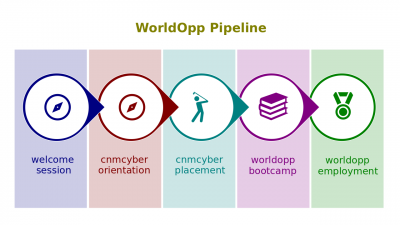Difference between revisions of "Workplace Conditions"
(→Script) |
|||
| (23 intermediate revisions by 2 users not shown) | |||
| Line 1: | Line 1: | ||
| − | [[ | + | [[Workplace Conditions]] (hereinafter, the ''Lectio'') is the second [[lectio|lesson part]] of the '''[[Nature of Work]]''' [[lesson]] that introduces its participants to [[work characteristic]]s and related topics. |
| − | [[File:Educaship-pipeline.png|400px|thumb|[[WorldOpp Pipeline]]]]This ''lesson'' belongs to the [[Introduction to Employment]] session of | + | [[File:Educaship-pipeline.png|400px|thumb|[[WorldOpp Pipeline]]]]This ''lesson'' belongs to the [[Introduction to Employment]] session of [[EmployableU Concepts]]. |
| Line 7: | Line 7: | ||
The predecessor [[lectio]] is [[Task Attributes]]. | The predecessor [[lectio]] is [[Task Attributes]]. | ||
| − | === | + | ===Script=== |
| − | : | + | :[[Workplace condition]]s refer to health and safety standards, workplace rules and other [[requirement]]s. |
| − | + | :Many of these ''requirements'' are imposed by [[labor law]]. They include, for instance, work hours and handling of hazardous materials. Other regulations such as a [[collective bargaining agreement]] ([[collective bargaining agreement|CBA]]) that the [[employer]] has no or no longer control of may also impose some ''requirements''. | |
| − | : | ||
| + | :Another ''requirements'' may be imposed by the [[employer]] and, what is very common, by managers and/or administrators, both direct and indirect, within the employing organization. | ||
| − | + | :Physical ''conditions'' such as light, fresh air, and place in the office, travels outside of the office, or [[telecommuting]] are most obvious. The other ''conditions'' refer to mental challenges. | |
| − | + | :[[Consequence of error]] is the degree to which the result of an error is serious. Some of those errors cannot be readily correctable; they are attributes of some professions such as a [[surgeon]] or, no doubts, [[sapper]]. Some of those errors are both preventable and correctable, but [[human factors]] interfere both prevention and mitigation. | |
| − | + | :For example, the [[Dirty Dozen of Human Factors]] is the twelve most common maintenance-related [[human factor]]s that are responsible for the majority of incidents and accidents in aviation. Industries like nuclear power and aviation practice special training for workers to deal not only with own errors, but also the ones of worker's supervisor. | |
| − | + | :Finally, the COVID-19 pandemic demanded physical distancing, [[work virtualization]], and other [[requirement]]s. | |
| − | : | + | ===Key terms=== |
| + | :[[Workplace condition]], [[workplace]], [[workspace]] | ||
| + | |||
| + | ===Closing=== | ||
| + | :Are you familiar with [[human factors]]? --Yes/No/Let's move on for now | ||
| − | + | '''[[Labor Laws]]''' is the successor [[lectio]]. | |
| − | + | ==Questions== | |
| − | |||
| − | |||
| − | == | + | ===Placement entrance exam=== |
Latest revision as of 20:52, 29 October 2023
Workplace Conditions (hereinafter, the Lectio) is the second lesson part of the Nature of Work lesson that introduces its participants to work characteristics and related topics.
This lesson belongs to the Introduction to Employment session of EmployableU Concepts.
Content
The predecessor lectio is Task Attributes.
Script
- Workplace conditions refer to health and safety standards, workplace rules and other requirements.
- Many of these requirements are imposed by labor law. They include, for instance, work hours and handling of hazardous materials. Other regulations such as a collective bargaining agreement (CBA) that the employer has no or no longer control of may also impose some requirements.
- Another requirements may be imposed by the employer and, what is very common, by managers and/or administrators, both direct and indirect, within the employing organization.
- Physical conditions such as light, fresh air, and place in the office, travels outside of the office, or telecommuting are most obvious. The other conditions refer to mental challenges.
- Consequence of error is the degree to which the result of an error is serious. Some of those errors cannot be readily correctable; they are attributes of some professions such as a surgeon or, no doubts, sapper. Some of those errors are both preventable and correctable, but human factors interfere both prevention and mitigation.
- For example, the Dirty Dozen of Human Factors is the twelve most common maintenance-related human factors that are responsible for the majority of incidents and accidents in aviation. Industries like nuclear power and aviation practice special training for workers to deal not only with own errors, but also the ones of worker's supervisor.
- Finally, the COVID-19 pandemic demanded physical distancing, work virtualization, and other requirements.
Key terms
Closing
- Are you familiar with human factors? --Yes/No/Let's move on for now
Labor Laws is the successor lectio.
